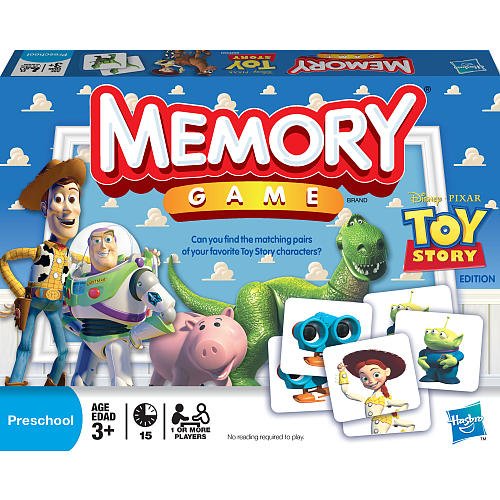
The Basics:
- Ages 3+
- Players 2 – 5
- 30 minutes (time can be adjusted by removing tiles)
Geek Skills:
- Memorization & Pattern Matching (yeah — hard to guess that one, huh?)
Learning Curve:
- Child – Easy
- Adult – Easy
Theme & Narrative:
- Memory comes in many different themes (Star Wars, Barbie, etc.)
Endorsements:
- Father Geek approved!
- Child Geek rejected!
Overview
This is the classic game of Memory and there is very little to say about it as the game is very straight forward. A group of tiles are shuffled and arranged on the table face down. Each tile has a match which will make one pair. On a player’s turn, they flip over two tiles, revealing them to all the other players. If the tiles are a matching pair, they are removed from the table and claimed by the player who made the match. Depending on the game, the player who makes a matching pair might also receive a bonus turn and go again. If the two tiles do not match, they are flipped back over and the next player takes their turn.
The winner of the game is the player who has the highest number of matching pairs.
Over the years, many different Memory games have been published with many different themes. The Memory game I played most recently with my kids was themed and based off of Toy Story 3. The number of matching pairs is dependent on the version of the game you play, but a typical game will have around 36 matching pairs for a total of 72 tiles. When playing with younger Little Geeks, it is recommended you reduce the number of tiles used. This will make the game faster and easier. Add additional tiles to make the game more difficult, and of course, longer.
Final Word
Well, I finally found a game my kids do not want to play. This is unfortunate, because the game really does help develop memory skills for children and adults. The suggested age is 3+, however I think for a 3 year old, you really need to reduce the tile sets if you want to have any chance of keeping their attention. I believe one of the reasons the game does not go over well for my kids (ages 4 and 2) is because it’s visually not very interesting to them.
My 4 year old has very good memory skills and was making quite a few matches. Even so, he quickly tired of the game before we were half done. This can be mitigated by reducing the tile set even further, as I mentioned in the overview.
For me, I think there is a reason why this is a classic. The core mechanic has been mixed into hundreds of games throughout the years. It’s a great way to exercise visual memory skills and does incorporate a small bit of strategy. For example, I had explained to my son that selecting the same first tile every time is not the best move.
More advanced than I can explain to him right now are the subtle advanced strategies you can use in the game. For example, when I flip over a tile and am fairly certain my opponents do not know where the matching tile is, I will purposely not flip over a guess for my 2nd tile and instead reveal a tile on the complete opposite end of the board that I know is not a match. Next turn, I’ll try to find the match with my first flip. These moves are intentionally designed to confused your opponent and reduce the amount of useful information regarding tile placement.
I hope to return this to our game table again in another year or so. For now, I need to stick to the flashy games to keep my kids interested. If you have Little Geeks that are 5+, please add a comment on when the challenge of the game became more appealing than the look of it.




Pingback: FlipOut » Father Geek
Pingback: » Spinnengift und Krötenschleim Game Review
Pingback: Scrapland Scramble Game Review » Father Geek
Pingback: Fish to Fish Game Review » Father Geek
Pingback: Hylaria Game Review (prepublished version) - Father Geek
Pingback: Te Kuiti Game Review - Father Geek
Pingback: Face to Face Game Review (prepublished version) - Father Geek